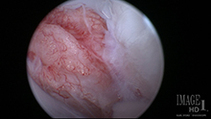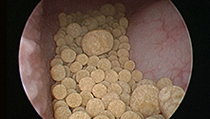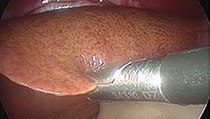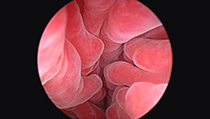Endoscopic procedures
Endoscopic Techniques (Minimally Invasive Surgery) have been developed in many areas of veterinary endoscopy to offer you and your pet less invasive alternatives to traditional open surgery. Some of the most common endoscopic procedures are listed below, but specialists are continuing to expand the application of endoscopic techniques to other areas. If your pet requires surgery, ask your veterinarian how endoscopy may be able to offer a less painful --and more effective-- option. If your vet does not offer endoscopy services, she or he may be able to refer you to a specialist who does. We are also available to provide you with a list of vets performing endoscopic surgery in your area. If your veterinarian is interested in learning more about the applications of veterinary endoscopy he can contact us for more information and a list of training opportunities.

Arthroscopy
is endoscopy of the joint space. It is used in cases of chronic lameness, joint pain, joint instability, swelling and abnormal radiographic findings.

Bronchoscopy
is endoscopy of the airways and lungs, to identify structural abnormalities, collect samples of abnormal airway secretions, identify and remove foreign bodies and biopsy lesions or masses.
Photo by Dr. Timothy McCarthy

Cystoscopy
is endoscopy of the urinary bladder, used in patients presenting with chronic infections, blood in the urine, straining to urinate, incontinence, trauma, urinary stones and abnormal radiographs.
Photo by Dr. Timothy McCarthy

Gastrointestinal Endoscopy
is the endoscopic exploration of the stomach and intestines. A partial list of indications includes chronic regurgitation, salivation, nausea, vomiting, blood in the stool, anorexia, diarrhea, weight loss, fecal mucus and straining to defecate. It is most commonly used for obtaining biopsies and the removal of foreign bodies.
Photo by Dr. Todd Tams

Gastropexy
is a preventative surgery that can be performed laparoscopically on at-risk dogs to prevent the twisting of the stomach, which is fatal if not treated quickly. The stomach is sutured to the abdominal wall in order to prevent the stomach from twisting. Endoscopy eliminates the need to perform open surgery, which requires an incision of 6" to 12". Gastropexy is often done at the time of laparoscopic spay.

Laparoscopy
is endoscopy of the abdominal cavity, used as a diagnostic tool for taking biopsies of the liver, kidney and pancreas. More advanced minimally invasive surgery being performed includes adrenalectomy, gastropexy, hernia repair and ovariectomy / ovariohysterectomy (spays).

Laparoscopic Spay
is a technique for neutering female cats and dogs. Performed through one to three small incisions in the abdomen rather than a large incision, it offers a less painful, safer and faster healing alternative to traditional spays. Other terms commonly used for spay throughout the world are ovaeriectomy, ovariohysterectomy, sterilization, sterilisation, desexing, neuter, castrastion and spey. In developing parts of the world, the technique can be employed for low-cost control of stray dog populations, since the dogs do not need to be housed and fed for very long after surgery and before release.

Otoscopy
is endoscopy of the external and middle ear. It is one of the most common applications of endoscopy in veterinary medicine. Otoscopy allows for safe and thorough ear cleaning under constant visualization, removal of foreign objects, polyp removal and diagnostic sampling.

Rhinoscopy
is endoscopy of the nasal cavity, commonly indicated in dogs and cats with chronic nasal discharge, nasal obstruction, chronic sneezing, nasal bleeding, facial distortion, nasal pain, acute severe sneezing, reverse sneezing and abnormal radiographs.
Photo by Dr. Timothy McCarthy

Vaginoscopy
is the endoscopic examination of the vagina. Indications for vaginoscopy include vaginal discharge, bleeding or masses, trauma, incontinence, foreign body removal and straining to urinate. Reproductive indications include transcervical artificial insemination, difficulty in labor and monitoring of the estrous cycle.